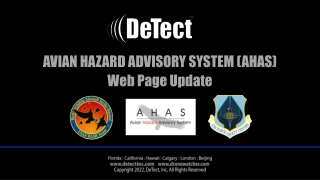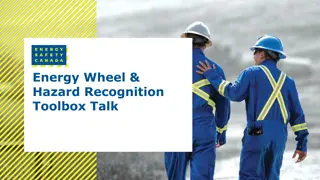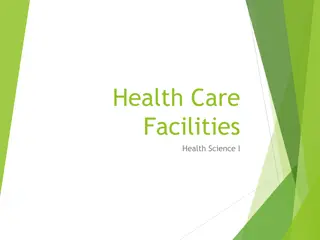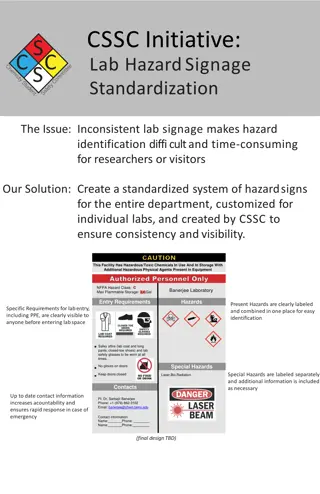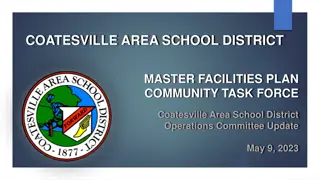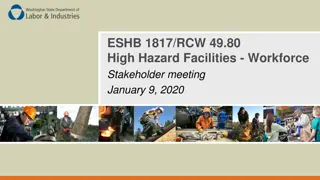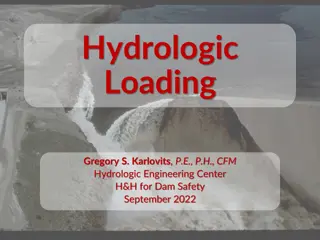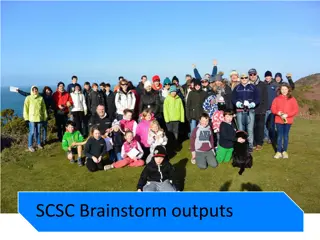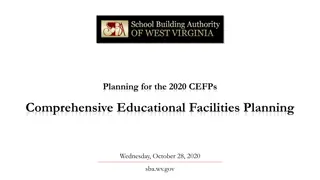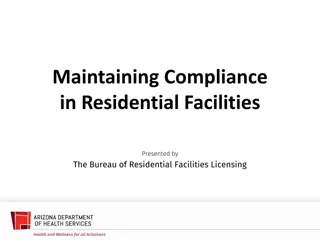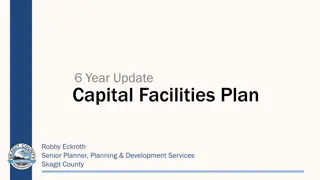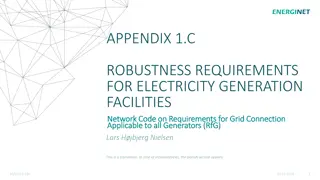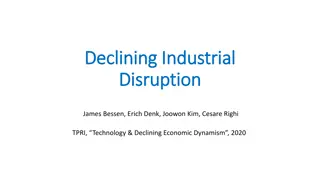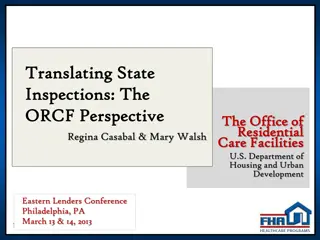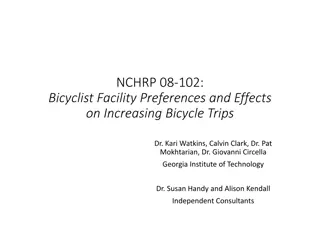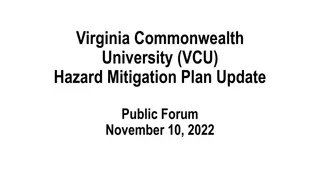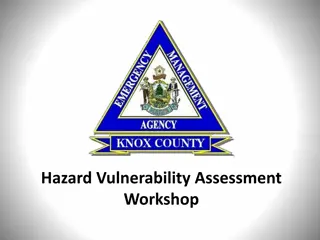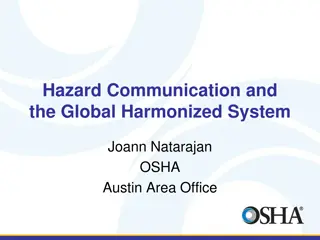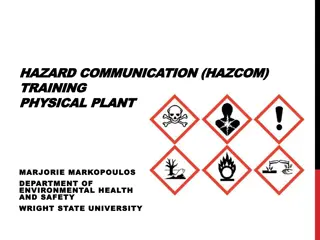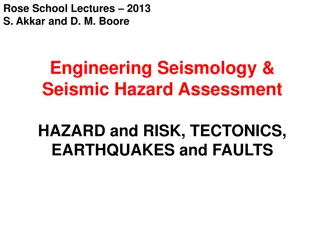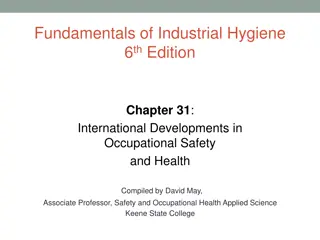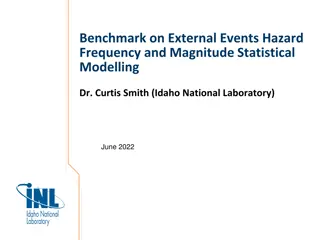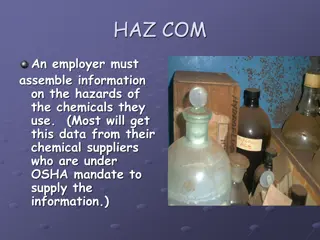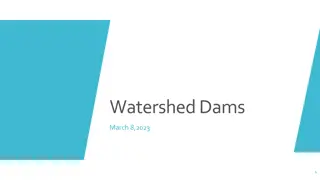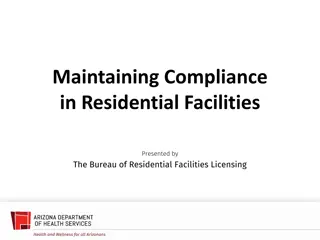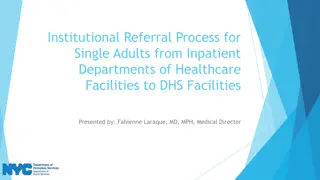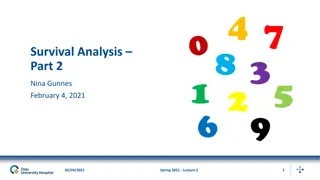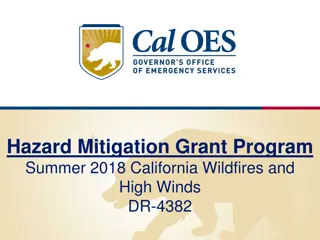Avian Hazard Advisory System (AHAS) Update
The latest updates to the Avian Hazard Advisory System (AHAS) providing crucial bird hazard information for flight safety. Learn about calculating NEXRAD risk, regional mosaics, flying areas, and risk management.
0 views • 23 slides
Energy Wheel & Hazard Recognition Toolbox Talk
Hazard recognition is crucial for safety in all activities. Hazards can range from gravity and motion to mechanical and chemical risks. Failure to identify hazards can lead to incidents, making tools like the Energy Wheel key for improving recognition. The Energy Wheel enhances hazard recognition by
2 views • 10 slides
Health Care Facilities
Explore a comprehensive guide to various health care facilities, including hospitals, long-term care facilities, medical offices, and clinics. Learn about the types of hospitals, such as general, specialty, government, and university hospitals. Discover the functions of long-term care facilities lik
0 views • 9 slides
Virginia Commonwealth University Hazard Mitigation Plan Update
The Virginia Commonwealth University (VCU) Hazard Mitigation Plan (HMP) Update Public Comment Meeting #1 took place on April 5, 2022. The meeting included introductions, overview of hazard mitigation planning, work plan details, data and information needs, next steps, and action items. Various commi
0 views • 20 slides
Standardized Hazard Signage for Lab Safety
Addressing the challenge of inconsistent lab signage hindering hazard identification, our solution introduces a standardized system for hazard signs within the department. By customizing signage for individual labs and ensuring consistency and visibility, researchers and visitors can easily identify
0 views • 8 slides
Coatesville Area School District Facilities Investment Plan Update
The Coatesville Area School District Operations Committee provided an update on the Master Facilities Plan, emphasizing the educational impact of facilities on student performance. The Community Task Force outlined priorities for renovations and new constructions to enhance student learning environm
0 views • 13 slides
ESHB 1817/RCW 49.80 High Hazard Facilities Stakeholder Meeting Overview
The stakeholder meeting discussed ESHB 1817 requirements for skilled and trained workforce in high hazard facilities, focusing on contractors in building and construction trades. It outlined exclusions, applicability, and exceptions to these workforce requirements. Key speakers included Maggie Lelan
0 views • 19 slides
Understanding Hazard Curves in Dam Safety Risk Assessments
This content focuses on the role of hazard curves in dam safety risk assessments, emphasizing the level of effort required for their development and the use of HEC software. It highlights the three components of risk (hazard, performance, consequence), discusses hazardous loads and potential consequ
1 views • 58 slides
Comprehensive Risk Assessment and Hazard Mitigation Planning
This work delves into risk assessment and hazard mitigation planning supported by the National Science Foundation. It covers the importance of hazard identification, risk assessment, and mitigation planning components. Mitigation actions are outlined to reduce risks to life and property, prevent dam
2 views • 20 slides
Facility Improvement Suggestions for Sailing Club
Detailed suggestions for enhancing facilities at a sailing club include needs and wants across various areas such as race management, changing rooms, galley facilities, dinghy berthing, social areas, training resources, and more. Specific needs like good slipway access and comfortable amenities are
0 views • 12 slides
Comprehensive Educational Facilities Planning Overview
Comprehensive Educational Facilities Planning is essential for identifying current and future facility needs, predicting life-cycle costs, and accommodating educational innovations. The process entails creating an ongoing implementation plan that acts as a to-do list for facilities and fosters commu
0 views • 33 slides
Ensuring Compliance in Residential Facilities by Arizona Department of Health Services
Presented by the Bureau of Residential Facilities Licensing, this training emphasizes the importance of compliance with Arizona's rules and statutes for various residential healthcare facilities. The program covers survey types, Plan of Correction preparation, common deficiencies, Compliance Team in
2 views • 73 slides
Optical Equipment Safety Review and Hazard Analysis
This document provides an in-depth review of the safety considerations for the ATST optical equipment, focusing on potential hazards associated with the M2 Mirror, Heat Stop Assembly, and other critical components. The Preliminary Hazard Analysis identifies various risks, causes, and recommended act
0 views • 13 slides
Proposed Facilities Referendum Overview in Montgomery Township School District
Explore the need for a proposed facilities referendum in Montgomery Township School District, detailing the reasons behind it, the facilities needs assessment, board committee review, and recommended projects such as improvements at Montgomery High School and Upper Middle School. Discover how this r
0 views • 17 slides
Probabilistic Tsunami Hazard Assessment Project for the NEAM Region
The project, coordinated by Istituto Nazionale di Geofisica e Vulcanologia (INGV) with various partners, aims to develop a region-wide Probabilistic Tsunami Hazard Assessment (PTHA) for the North East Atlantic and Mediterranean coastlines. It involves creating PTHA database and maps, engaging intern
0 views • 10 slides
Skagit County Capital Facilities Plan Update Overview
Skagit County is updating its Capital Facilities Plan to ensure public facilities and services support future development without decreasing current service levels. Internal changes include relocation of the Public Health Department and upgrades to facilities, while external changes involve updates
0 views • 6 slides
Enhancing Safety through Systematic Hazard Combinations Analysis in NPP Design Basis & PSA at NPP Paks
In this preparatory study, Tamas Siklossy, Attila Bareith, and Barnabas Toth discuss the importance of considering hazard combinations in the design basis and PSA of the Paks NPP in Hungary. The study reviews current practices, outlines technical tasks, and emphasizes the need to assess the impact o
0 views • 17 slides
Robustness Requirements for Electricity Generation Facilities
The document outlines robustness requirements for electricity generation facilities, covering fault-ride-through properties, clear time and voltage parameters for different types of generation facilities connected to both the distribution grid and transmission grid. Specific requirements for synchro
0 views • 8 slides
Declining Competition and Industrial Disruption Study
Research conducted by James Bessen, Erich Denk, Joowon Kim, and Cesare Righi focuses on the trends in competition and industrial disruption, with a specific emphasis on the hazard of displacing top firms, impacts of investments by dominant firms, and the relationship between displacement hazard, mar
0 views • 38 slides
Importance of Licensure Compliance in Residential Care Facilities
This presentation delves into the critical role of licensure compliance in ensuring the success and viability of residential care facilities. The focus is on the Office of Residential Care Facilities' (ORCF) perspective, emphasizing the significance of maintaining provider status/licenses in securin
0 views • 39 slides
Integrated Healthcare Waste Management and WASH in Healthcare Facilities
National Workshop on Integrated Healthcare Waste Management (IHCWM) and Water Sanitation & Hygiene (WASH) in Healthcare Facilities highlighted the importance of following national standards, guidelines, and strategies for effective management of healthcare waste and ensuring proper water, sanitation
0 views • 32 slides
Understanding Bicyclist Facility Preferences for Increasing Bicycle Trips
This research study aims to investigate the various preferences and effects of different bicycle facilities on increasing bicycle trips. It explores how individual preferences for bike facilities differ and the effectiveness of these facilities in attracting new trips. The study delves into the impa
0 views • 52 slides
FEAD Committee Meeting on Security and Fires in Waste Management Facilities
The FEAD Committee's upcoming meeting on 14th February 2023 will cover various legislative updates and discussions on security and fires in waste management facilities. The agenda includes updates on legislative files, such as the revision of EU legislation on hazard classification and waste shipmen
0 views • 23 slides
Seismic Site Characterization in Metropolitan Vancouver
The Greater Vancouver area faces high seismic risk due to its population density and critical infrastructure. Ground shaking during large earthquakes depends on various factors including the earthquake source, material properties, and site conditions. Efforts are being made to map seismic hazards, u
0 views • 13 slides
Virginia Commonwealth University (VCU) Hazard Mitigation Plan Update Public Forum
Virginia Commonwealth University (VCU) is updating its Hazard Mitigation Plan to address natural, human-caused, and technological threats affecting the campus. The plan aims to lessen disaster impact, assess vulnerabilities, develop mitigation strategies, and prioritize high-risk areas. VCU's rich h
0 views • 40 slides
Comprehensive Hazard Vulnerability Assessment Workshop and Tools
In this collection of images and descriptions, various aspects of Hazard Vulnerability Assessment (HVA) workshops, tools, and scoring methods are covered. Topics include risk assessment, planning policies, human factors, probability considerations, environmental and non-environmental hazard scoring,
0 views • 21 slides
Understanding Hazard Communication and the Global Harmonized System
This content discusses the changes introduced by the Global Harmonized System in Hazard Communication Standards (HCS). It highlights the impact on classifications, labels, safety data sheets, and information and training requirements. The GHS aims to enhance workplace safety by providing a standardi
0 views • 37 slides
Combining Natural Hazards with Societal Issues: Unit 1 Hazard Map Template
Delve into Unit 1 of the Hazard Map Template, identifying and locating regions susceptible to hazards by choosing top hazards in the mapping area. Create hazard maps, combine shapes, and include a key and sources for a comprehensive view of potential hazards and vulnerabilities.
0 views • 13 slides
Risk Assessment and Hazard Mitigation Overview
This document introduces risk assessment and hazard mitigation planning, supported by the National Science Foundation. It outlines the key components of risk assessment and hazard mitigation planning, emphasizing the importance of identifying and addressing the greatest risks. The process includes h
0 views • 20 slides
Importance of Hazard Communication Training for Workplace Safety
Hazard communication training is essential for creating a safe work environment by helping individuals recognize and manage hazardous materials effectively. Understanding the Globally Harmonized System (GHS) and following hazard communication laws can improve workplace safety, protect human health,
0 views • 36 slides
Hazard Communication Training and Safety Data Sheets Overview
This resource provides detailed information on hazard communication training, safety data sheets (SDS), GHS format elements, HMIS and NFPA labeling systems, GHS symbols, and building safety precautions. It covers essential aspects such as hazard identification, SDS requirements, chemical labeling, G
0 views • 39 slides
Engineering Seismology & Seismic Hazard Assessment Lectures Overview
This content provides detailed information on the Rose School Lectures 2013 by Sinan Akkar and D. M. Boore focusing on Engineering Seismology & Seismic Hazard Assessment. It includes course schedules, instructor details, contact information, and online software used. Topics covered range from hazard
0 views • 10 slides
Global Harmonized System of Classification and Labeling of Chemicals (GHS) Overview
The Global Harmonized System of Classification and Labeling of Chemicals (GHS) was developed to address the inconsistencies in hazard information for chemicals globally due to significant trade. The history, mandate, and provisions of GHS, along with additional domestic harmonization efforts, are di
0 views • 29 slides
Statistical Modelling of Hazard Frequency and Magnitude in External Events
Dr. Curtis Smith from Idaho National Laboratory presented a benchmark on External Events Hazard Frequency and Magnitude Statistical Modelling. The background involves the Working Group on External Hazards (WGEV) addressing the challenges in formulating and assessing external event initiating events
0 views • 11 slides
Hazard Communication in the Workplace
Employers must gather information on the hazards of chemicals they use and communicate this information to workers through training, labeling, and access to Safety Data Sheets (SDSs) as per OSHA Hazard Communication Standard (1910.1200). Hazard Communication Program (HCP) training covers chemical ex
0 views • 20 slides
Watershed Dams Rehabilitation Program in Kentucky
The Watershed Dams Rehabilitation Program in Kentucky aims to address the critical need for rehabilitating high hazard dams to ensure public safety and prevent economic damage. With funds allocated for grant programs and local sponsor matches, the initiative targets key priority dams identified by t
0 views • 8 slides
Guidelines for Compliance in Residential Facilities by Arizona Bureau
This comprehensive document outlines the compliance guidelines for residential facilities, presented by the Bureau of Residential Facilities Licensing in Arizona. It covers topics such as surveys, Plan of Correction preparation, common deficiencies, enforcement trends, and navigating additional reso
0 views • 73 slides
Institutional Referral Process for Single Adults from Inpatient Departments to DHS Facilities
This presentation outlines the institutional referral process for single adults from inpatient departments of healthcare facilities to DHS facilities, focusing on screening referrals, coordinating care for medically appropriate individuals, and improving health outcomes. It covers goals, the shelter
0 views • 51 slides
Understanding Survival Analysis: Hazard Function and Cox Regression
Survival analysis examines hazards, such as the risk of events occurring over time. The Hazard Function and Cox Regression are essential concepts in this field. The Hazard Function assesses the risk of an event in a short time interval, while Cox Regression, named after Sir David Cox, estimates the
0 views • 20 slides
Mitigating California Wildfires: Hazard Mitigation Grant Program Overview
The Hazard Mitigation Grant Program (HMGP) aims to reduce loss of life and property from future disasters by implementing long-term risk reduction strategies. The program focuses on creating or updating Local Hazard Mitigation Plans, prioritizing post-wildfire mitigation activities, including soil s
0 views • 18 slides
